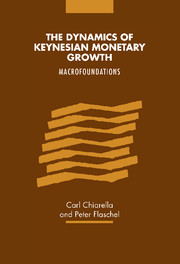Book contents
- Frontmatter
- Contents
- List of figures
- Foreword by Richard H. Day
- Preface
- Acknowledgments
- Notation
- General introduction
- 1 Traditional monetary growth dynamics
- 2 Tobinian monetary growth: the (neo)Classical point of departure
- 3 Keynes–Wicksell models of monetary growth: synthesizing Keynes into the Classics
- 4 Keynesian monetary growth: the missing prototype
- 5 Smooth factor substitution: a secondary and confused issue
- 6 Keynesian monetary growth: the working model
- 7 The road ahead
- References
- Author index
- Subject index
1 - Traditional monetary growth dynamics
Published online by Cambridge University Press: 22 September 2009
- Frontmatter
- Contents
- List of figures
- Foreword by Richard H. Day
- Preface
- Acknowledgments
- Notation
- General introduction
- 1 Traditional monetary growth dynamics
- 2 Tobinian monetary growth: the (neo)Classical point of departure
- 3 Keynes–Wicksell models of monetary growth: synthesizing Keynes into the Classics
- 4 Keynesian monetary growth: the missing prototype
- 5 Smooth factor substitution: a secondary and confused issue
- 6 Keynesian monetary growth: the working model
- 7 The road ahead
- References
- Author index
- Subject index
Summary
Introduction
We reconsider in this chapter the leftover ruins of traditional monetary growth dynamics which, with respect to the general dynamics they can give rise to, have so far been poorly analyzed and understood in the literature.
We attempt to show to the reader, in section 1.2 in overview, and in detail in chapters 2–5, that these leftover ruins can be arranged and represented in a systematic way so that they form a hierarchical structured class of monetary growth models where each subsequent model type eliminates some of the weaknesses of the preceding model type. We then indicate in section 1.2 two ways in which this methodological approach to macrodynamics can be significantly extended beyond the existing scope of traditional models of monetary growth. Firstly, this way of proceeding in fact leads to the establishment of a proper (still traditional), but much neglected Keynesian model of monetary growth where both labor and capital exhibit fluctuating degrees of utilization independently of the assumptions that are made on “technology”. Secondly, our approach leads to a further improvement of this IS–LM growth type of dynamics by allowing for sluggish price, as well as quantity, adjustments (two Phillips-curve mechanisms and a Metzlerian treatment of disappointed sales expectations) and by establishing thereby what we will call the working Keynesian model of this book.
- Type
- Chapter
- Information
- The Dynamics of Keynesian Monetary GrowthMacro Foundations, pp. 10 - 68Publisher: Cambridge University PressPrint publication year: 2000
- 3
- Cited by



